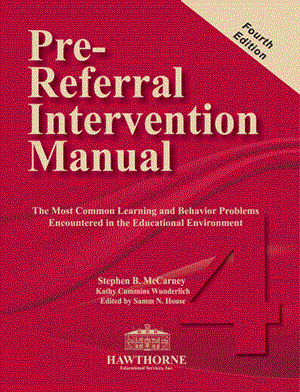Learning Disability Intervention Manual
- Learning Disability Intervention Manual
- Learning Intervention Manual Hawthorne
- Reading Learning Disability Interventions
The Learning Intervention Manual CD-ROM is a Windows®-compatible product designed to be used in conjunction with the Learning Intervention Manual. It provides the user with the ability to maintain individual student reports, the ability to print appendix pages, and three report options: generates a printout of chosen goals, objectives, and intervention strategies to be implemented for a student prior to any formal assessment. Provides a report of chosen intervention strategies and dates of implementation. The implementer indicates which intervention strategies have been successful/unsuccessful for each behavior. Documents each area of the functional behavior assessment process including antecedents, goals, objectives, and intervention strategies for each selected behavior. To order: Check box next to product then Add To Cart 02620 Learning Intervention Manual (Includes: CD with Appendix PDF File) $0 Learning Checklists (25) $2 Intervention Strategies Documentation Forms (25) $40.00 COMPUTER PROGRAMS: All computer programs must be used with the companion manuals and/or rating forms. (See.) 02621 LIM (Windows®) (Opened software cannot be returned.

Please download the to determine if this software meets your requirements.) $230.00 MULTI-SITE LICENSE Multi-site licenses are available for intervention manual programs for $150.00 per license after the full purchase price of one program. The license grants the user the right to install the program at three sites (i.e., three computers). A link for the Multi-site license will be available from the shopping cart after the Intervention Manual CD has been added.
The National Research Center on Learning Disabilities (Lawrence, KS) prepared this manual as a tool for implementing Responsiveness to Intervention (RTI). The manual can help schools understand, design, and evaluate the RTI features that they will implement. This RTI Manual is based on current research regarding the features of RTI. While striving to present comprehensive coverage of the critical features of RTI, it also includes numerous resources for pursuing further information.
Learning Disability Intervention Manual

RTI is defined as an assessment and intervention process for systematically monitoring student progress and making decisions about the need for instructional modifications or increasingly intensified services using progress monitoring data. The following is the fundamental question of RTI procedures: Under what conditions will a student successfully demonstrate a response to the curriculum? The goal of this manual is to help school think about implementing RTI in terms of manageable concrete steps. The RTI Manual includes the following sections: (1) School-Wide Screening; (2) Progress Monitoring; (3) Tiered Service Delivery; (4) Fidelity of Implementation; and (5) School Examples, Student Case Studies, and Research Examples. The first four sections of the RTI Manual follows a consistent format for presenting information and tools to implement RTI.
They first present overviews, definitions, and features of the relevant RTI component to orient the reader to each RTI component and develop an understanding of its critical features and role within the larger system of RTI. Included in each component section is an evaluation tool outlining the features that currently define best practice. Next, a planning tool is provided that schools can use to determine specifics about implementing the essential tasks for each RTI component. Finally, the last section of this manual, 'School Examples, Student Case Studies, and Research Examples,' presents descriptions of how model sites identified through anNRCLD research study have implemented specific components of RTI, the resources required, and the challenges they faced.
Learning Intervention Manual Hawthorne
The section also describes longitudinal data from individual students who have received services under an RTI delivery model. It concludes with descriptions of research studies in which RTI models have been implemented.
Reading Learning Disability Interventions
This document was produced by the National Research Center on Learning Disabilities.





